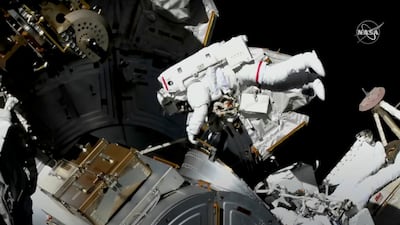This week is set to be the busiest yet in the UAE's space programme, with the Rashid rover expected to land on the lunar surface and an Emirati astronaut embarking on a spacewalk.
They are among some of the most historic and challenging missions attempted by the country's engineers, scientists, researchers and astronaut.
Rashid, a 10kg four-wheel rover, is scheduled for a lunar landing aboard the Japanese Hakuto-R Mission 1 spacecraft at 8.40pm GST on April 25.
Only three days later, Sultan Al Neyadi will step outside of the International Space Station for a six-and-a-half-hour spacewalk.
He is set to become the first Arab astronaut to perform the feat.
Rashid rover's lunar landing
Emirati engineers at the Mohammed bin Rashid Space Centre are preparing for what could be the first Arab spacecraft on the surface of another celestial body.
The Rashid rover has travelling to the Moon, stored safely inside the ispace's Hakuto-R M1 lander, for five months.
On Tuesday, the Japanese spacecraft will attempt a soft landing on the lunar surface.
If successful, the Rashid rover will then be placed on the surface using a pair of mechanical arms on the lander.

After health checks carried out remotely by engineers, the rover will begin its 14-day science mission, including studying the Moon's geology, soil and dust and capturing images.
ispace will live stream an event in Tokyo, Japan, on landing day on the company's YouTube channel.
Only the US, former Soviet Union and China have soft landed on the lunar surface before.
India and Israel had failed attempts in 2019.
Lunar landings are extremely difficult because the Moon has no atmosphere and complex manoeuvres are required to slow down the spacecraft and land safely.
If ispace succeeds, it will make the company the first to achieve a private mission to the Moon.
Emirati astronaut's spacewalk
Another milestone moment for the Emirates is Dr Al Neyadi's planned spacewalk on April 28.
The UAE astronaut arrived on the International Space Station on March 3 for a six-month mission.
A daring task now awaits him, in which he must leave the comfort of the orbiting post and float outside to retrieve a piece of communication hardware.

He will spend time outside the space station with Nasa colleague Stephen Bowen, who already has seven spacewalks to his name.
The six-and-a-half-hour spacewalk will be live streamed on Nasa and MBRSC's website and social media channels.
Live footage will show the duo tied only to a tether and holding on to the exterior of the station with their bulky gloves while carrying out their task.
Hope probe studying Mars's Moon Deimos
Emirati engineers also continue to stay busy with the discoveries of the Hope probe.
The spacecraft entered Mars's orbit on February 9, 2021, and has since been making landmark discoveries, from mysterious auroras on the planet's atmosphere to tracking enormous dust storms.
The National reported in February that the probe had moved to a new orbit around Mars to study one of the planet’s tiny moons.
Deimos, which measures only 6.2km in radius, is the smaller of the two moons that orbit the Red Planet.
The first Deimos fly-by took place in late January, and as the probe moves to its closest approach to the moon, it will take high-resolution images.
It will also continue to study atmospheric conditions on Mars. So far, the Emirates Mars Mission team have released six batches of data on the Red Planet, more than 1.7 terabytes.





